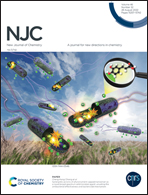Hemiacetal-linked pH-sensitive PEG-lipids for non-viral gene delivery†
Abstract
Cationic lipid–deoxyribonucleic acid complexes (CL–DNAs) are promising delivery systems for gene therapy applications. However, their poor performance in vivo is linked to their unspecific interactions with serum proteins and rapid clearance from the blood stream. PEGylation, the insertion of PEG molecules on the surface of a particle, improves the shielding of CL–DNAs from foreign bodies, ultimately increasing their circulation time. The drawback of this functionalization, however, is the significant decrease of the rate of endosomal escape by the CL–DNAs. To combat this, a pH-cleavable bond can be inserted into the PEG-lipid to drive the shedding of the PEG to occur inside the endosome as the pH slowly decreases. Herein, to facilitate the endosomal escape of CL–DNAs, we report two new hemiacetal-based methoxy PEG lipids (mPEG-Cn-lipid) with different lengths between the PEG and the lipid. The shorter mPEG-C2-lipid showed higher stability under physiological pH and faster hydrolysis under acidic pH than the C3 derivative. 1,2-Dioleoyl-3-trimethylammonium propane (DOTAP)-based CL–DNAs containing mPEG-C2-lipid showed average particle sizes of 170 nm, which remained stable in the cell medium, while particles without the mPEG-C2-lipid flocculated rapidly. Transfection studies on human embryotic kidney cells (HEK 293T) showed higher efficiency for all conditions with cleavable PEG as compared to the non-cleavable counterpart, whereas transfection in complete cell medium resulted in a general decrease in efficiency.



 Please wait while we load your content...
Please wait while we load your content...